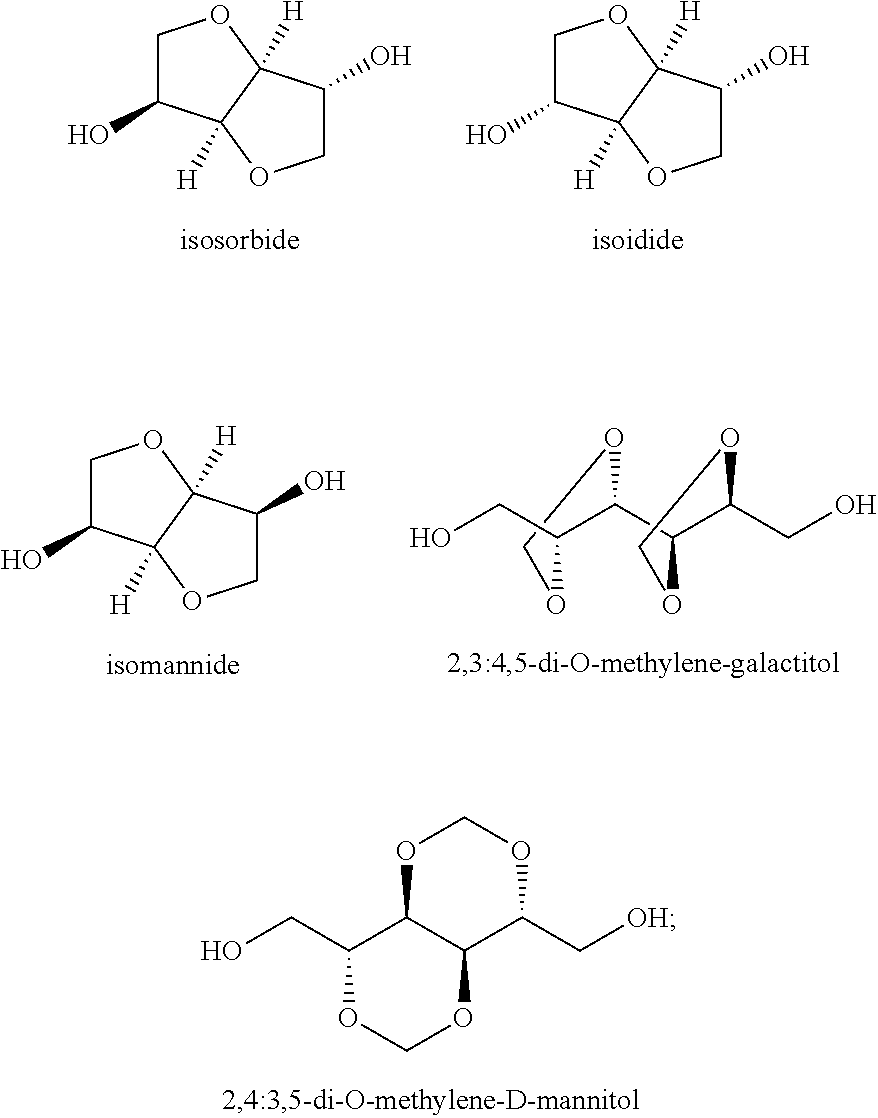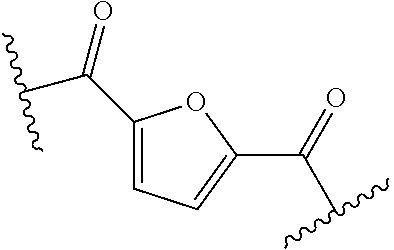Polyesters comprising 2,5-furandicarboxylate and saturated diol units having a high glass transition temperature
a technology of saturated diol and polycarboxylate, which is applied in the field of polymer, which can solve the problems of plastics becoming inescapable in the mass production of objects, partially biosourced, and the inability to synthesis fully biosourced pet products, etc., to achieve the effect of commercial success, and the synthesis of biosourced terephthalic acid or biosourced terephthalic acid ester remains too expensive to da
- Summary
- Abstract
- Description
- Claims
- Application Information
AI Technical Summary
Benefits of technology
Problems solved by technology
Method used
Image
Examples
example 1
of poly(ethylene-co-isosorbide furanoate) Polyester According to the Invention
[0151]In a 200 mL glass reactor were added 50.0 g of dimethyl-2,5-furanedicarboxylate (0.27 mol), 27.0 g of ethylene glycol (0.43 mol), 15.8 g of isosorbide (0.11 mol) and 0.08 g of titanium tetrabutoxide. The temperature was increased to 160° C. at a constant stirring of 150 rpm under nitrogen flow. The temperature was hold for 1 hour and then further increased to 190° C. The trans-esterification rate was estimated from the quantity of distillate collected. In the second step, the pressure was reduced to 5 mbar in 90 min and the temperature was gradually increased to 240° C. Low pressure conditions were maintained for 210 min.
[0152]The resulting polyester had a reduced viscosity of 26.2 mL / g (25° C., 5 g / L, Phenol: 1,2-dichlorobenzene (50:50)). The chemical analysis of the PEIF by NMR gave an isosorbide content of 19.8 mol % regarding to the diol content. The molar mass of the polymer was Mn=9 600 g / mol a...
example 2
of poly(ethylene-co-isosorbide furanoate) Polyester According to the Invention
[0161]In a 2 L stainless steel reactor were added 770 g of dimethyl-2,5-furanedicarboxylate (4.2 mol), 442 g of ethylene glycol (7.1 mol), 183 g of isosorbide (1.3 mol), 0.171 g of dibutyltin (IV) oxide, 0.183 g of Irgamod 195 and 0.05 g of sodium acetate. To exclude as much as possible residual oxygen from the reactor, four vacuum-nitrogen cycles were carried out between 60 and 80° C. at a constant stirring of 20 rpm. Then temperature was increased to 130° C. and the stirring was progressively increased to 150 rpm. The reaction mixture was then heated to 190° C. under 1.2 bar nitrogen pressure and stirred at a constant rate (150 rpm). The trans-esterification rate was estimated from the quantity of distillate collected. Then 0.484 g of titanium isopropoxyde were added in the reactor. In the second step, the pressure was reduced to 1 mbar in 90 min and the temperature was gradually increased to 240° C. Low...
example 3
of poly(ethylene-co-isosorbide furanoate) Polyester According to the Invention
[0163]In a 2 L stainless steel reactor were added 770 g of dimethyl-2,5-furanedicarboxylate (4.2 mol), 442 g of ethylene glycol (7.1 mol), 183 g of isosorbide (1.3 mol), 1.153 g of titanium tetrabutoxide, 0.183 g of Irgamod 195 and 0.05 g of sodium acetate. To exclude as much as possible residual oxygen from the reactor, four vacuum-nitrogen cycles were carried out between 60 and 80° C. at a constant stirring of 20 rpm. Then temperature was increased to 130° C. and the stirring was progressively increased to 150 rpm. The reaction mixture was then heated to 190° C. under 1.2 bar nitrogen pressure and stirred at a constant rate (150 rpm). The trans-esterification rate was estimated from the quantity of distillate collected. In the second step, the pressure was reduced to 1 mbar in 90 min and the temperature was gradually increased to 240° C. Low pressure conditions were maintained for 145 min until the torqu...
PUM
| Property | Measurement | Unit |
|---|---|---|
| molar ratio | aaaaa | aaaaa |
| glass transition temperature | aaaaa | aaaaa |
| temperature | aaaaa | aaaaa |
Abstract
Description
Claims
Application Information
 Login to View More
Login to View More - R&D
- Intellectual Property
- Life Sciences
- Materials
- Tech Scout
- Unparalleled Data Quality
- Higher Quality Content
- 60% Fewer Hallucinations
Browse by: Latest US Patents, China's latest patents, Technical Efficacy Thesaurus, Application Domain, Technology Topic, Popular Technical Reports.
© 2025 PatSnap. All rights reserved.Legal|Privacy policy|Modern Slavery Act Transparency Statement|Sitemap|About US| Contact US: help@patsnap.com



